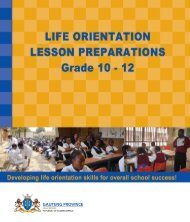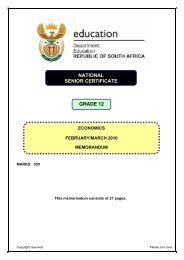Life Science Grade 11
Life Science Grade 11
Life Science Grade 11
You also want an ePaper? Increase the reach of your titles
YUMPU automatically turns print PDFs into web optimized ePapers that Google loves.
<strong>Grade</strong> <strong>11</strong> <strong>Life</strong> <strong>Science</strong>s Lesson Plans• The solid curds are moulded into cheeses after being washed and salted• Yoghurt is made in a similar way• Some cheese is made using moulds• Spores of Penicillium roqueforti are used to make the blue-vein cheeses.• Some spores of fungi are sprayed onto the surface of cheeses such as brie andcamembert and give the cheeses their characteristic flavours• Bread rises while baking because of the carbon dioxide that is released by yeastduring this process and is another example how micro-organisms are useful• The process of fermentation is a type of anaerobic respiration where sugars areconverted into ethanol and carbon dioxide by the action of micro-organisms• Have learners complete the activity on micro-organisms and traditional technology• Alternatively have learners bring samples of products such as various cheeses ,yoghurt and bread that are produced locally1. Learners complete theactivity by answeringquestions in theirworkbook15 min• Solutions for all <strong>Life</strong> <strong>Science</strong>s Gr.<strong>11</strong> Classroom Activity 18 pp. 503.2 Conclusion• Consolidate the information on micro-organisms and traditional means of makingbeers, wines and cheeses• If time allows have learners bring samples of cheeses and breads that have beenmade locally• The activities may be completed for homework5 minReflection/Notes:Name of Teacher:HOD:Sign:Sign:Date:Date:Term 1 Page 25© Gauteng Department of Education (CAPS version)







